Getting dressed for school in the summer over 40 is its own kind of struggle.
You’re rushing to beat the heat, trying to stay professional, and half the time wondering why your favorite clothes just don’t feel right anymore.
This guide is about the real summer clothing mistakes. Teachers over 40 often make the quiet wardrobe habits we fall into when we’re too busy showing up for everyone else.
These aren’t shallow tips. They’re lived-in moments: the blouse that used to feel polished but now feels off… the pants that cling by second period… the neckline you’ve adjusted three times before noon.
If any of that sounds familiar? You’re not alone. You’re not failing. But your clothes might not be serving the woman you’ve become.
Because a style over 40, especially as a teacher, isn’t about chasing trends. It’s about comfort that carries presence, fabrics that breathe with you, and outfits that support who you are today.
No, you don’t need a whole new wardrobe.
But maybe, just maybe, it’s time to let go of the pieces that no longer reflect your clarity or confidence.
Let’s talk about the signals, the shifts, and the subtle ways your summer wardrobe might be speaking even if you haven’t heard it yet.
Here are 20 real-life summer clothing mistakes teachers over 40 quietly make… and how to recognize when it’s time for something better.
1. Still Wearing That Tee From Five Summers Ago?
It’s soft. Familiar. You’ve worn it through lesson planning marathons, parent meetings, maybe even a few Friday pizza parties. And on rushed mornings, it still feels like the easiest answer.
But lately, something’s off.
The fabric doesn’t drape the way it used to. The collar sags a little. The color isn’t quite what it once was, maybe it’s faded, or just tired in a way that mirrors how you sometimes feel walking into the classroom.
That tee didn’t change overnight. You just stopped noticing. Because comfort has a way of disguising what we’ve outgrown.
But here’s the thing: You haven’t stopped showing up. You’ve just quietly evolved past the pieces that no longer rise with you.
And maybe… that tee’s time is done.
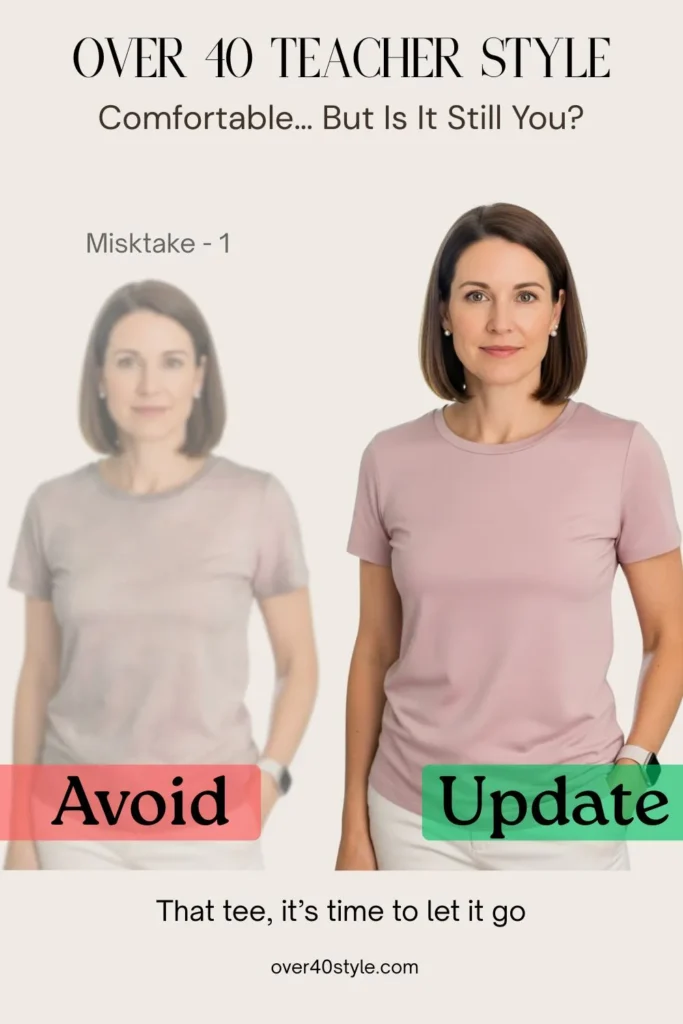
2. Still Wearing Clothes That Don’t Quite Fit Anymore
You know the feeling before you even leave the house the tug at the waistband, the shoulder that pulls a little too tight, that one button that gaps even when you’re standing still.
You tell yourself it’s not that bad. And maybe it’s not… for the first hour.
But by mid-morning, you’re adjusting. Sitting cautiously. Avoiding that stretch or reach you used to do without thinking.
And the truth is the clothes haven’t betrayed you. You’ve simply grown. Not in size, necessarily, but in life, in movement, in presence. And clothes that once felt right may now be asking too much of your energy just to wear them.
When an outfit demands constant attention, it steals something: focus, confidence, ease.
You shouldn’t have to shrink, suck in, or shift to fit your clothes.
They should move with you. Not against you.
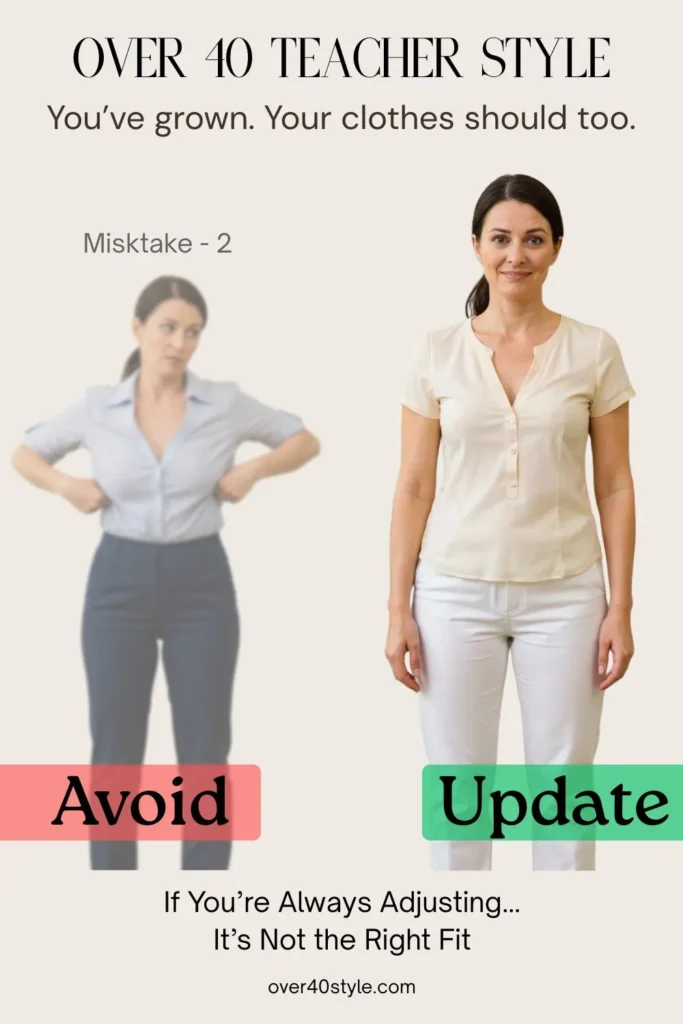
3. Choosing Fabrics That Trap More Heat Than They Release
It looks polished on the hanger. Maybe even elegant. But by second period, you’re silently regretting everything.
Some synthetic fabrics cling where they shouldn’t. They trap heat, hold moisture, and leave you feeling distracted not just physically, but mentally too. And when your body is in a battle with your clothes, your focus can start to slip.
You might power through. We always do. But comfort isn’t a luxury not in your role. It’s the foundation of presence.
Because when your clothes breathe, so do you. And that matters more than it sounds.
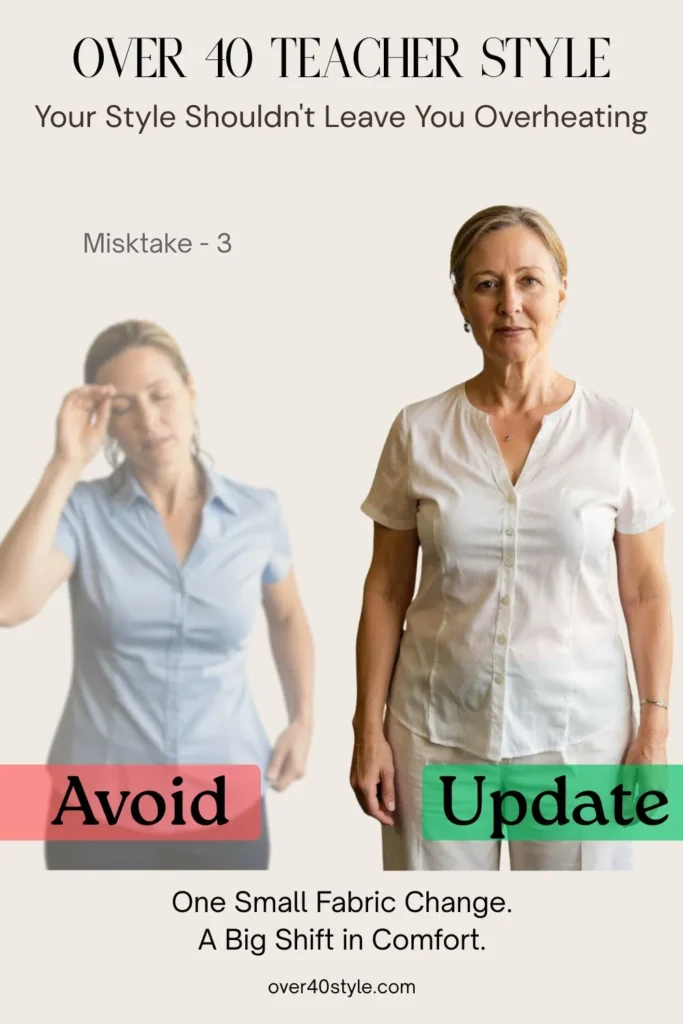
4. Thinking Black Always Works—Even in Summer
Black is easy. It feels safe. It flatters, hides, and polishes until the sun hits.
In cooler months, it grounds you. But in summer, especially in bright classrooms or outdoor school events, it can feel heavy. Harsh. Like your clothes are absorbing the day instead of helping you move through it.
Wearing all black in July doesn’t make you look more put-together, it makes you look and feel like you’re melting in slow motion.
It doesn’t mean black is off-limits. But when every outfit becomes a shadow version of yourself, you might be missing the chance to soften. To shift. To breathe in color, in presence, in ease.
Maybe this summer is the season to ask: What else could speak for me today besides black?
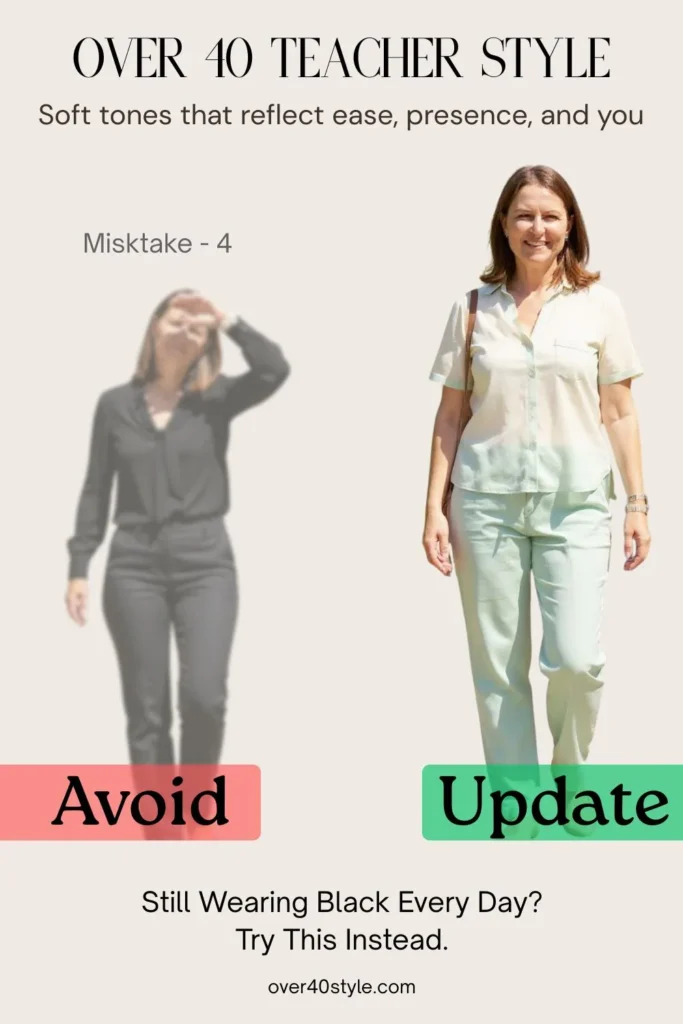
5. Wearing Sheer or Thin Fabrics Without Realizing It
It doesn’t happen all at once. A blouse you once loved, soft from wear, gradually loses its shape and its coverage.
You think it’s fine. You’ve worn it a hundred times. But one morning under bright classroom lights or a sunny window, you catch a glimpse… and realize it’s more transparent than you thought.
It’s not a crisis it’s a quiet signal.
Fabrics age, just like we do. They soften, stretch, and sometimes show more than we intended. And when that happens, it’s not about modesty. It’s about control over how we show up, how we’re seen, and how we feel when we walk into the room.
Because presence isn’t just about what you wear. It’s about knowing your clothes are working with you, not revealing things you didn’t sign up for.
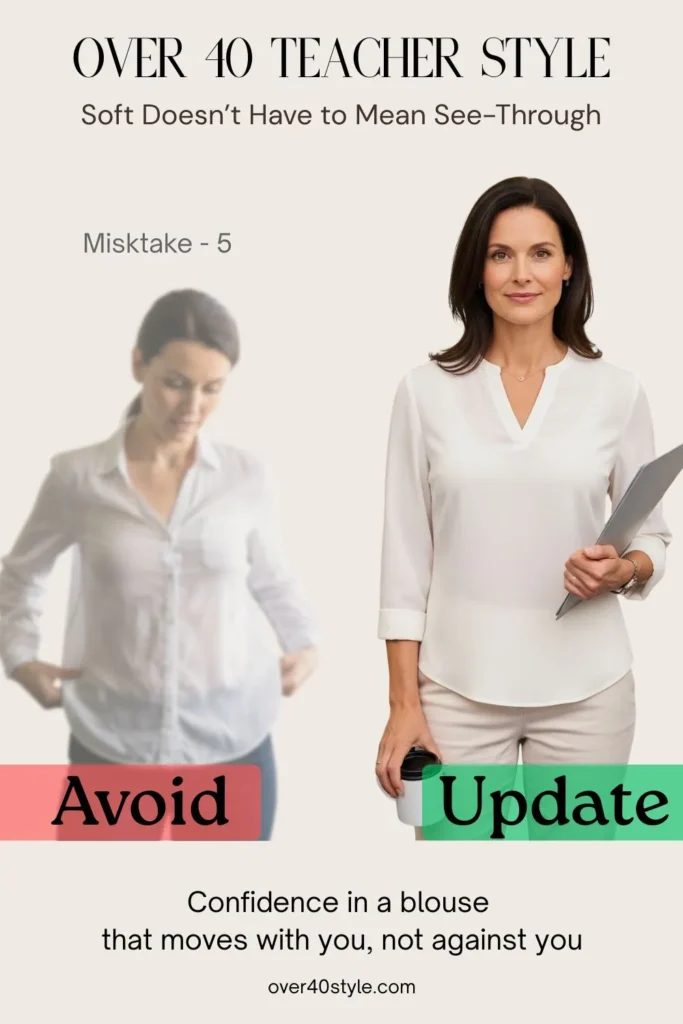
6. Not Noticing When White Turns… Not So White
It’s a quiet kind of fading.
That crisp white blouse you used to love? Over time through washes, wear, and classroom chaos it slowly shifts. Not enough to throw it out, but enough to dull your presence.
Under your bathroom light, it still looks fine. But under hallway fluorescents or morning sun through the classroom window? It is beige. Or gray. Or just… tired.
You don’t feel tired. So why let your clothes whisper that story?
White is powerful when it’s clean and clear it signals presence, precision, calm. But once it starts to lose its sharpness, it can reflect back something you never meant to say: worn down, washed out.
It’s not about perfection. It’s about awareness.
Because sometimes, the only thing standing between you and feeling sharp again… is letting go of a shirt that no longer is.
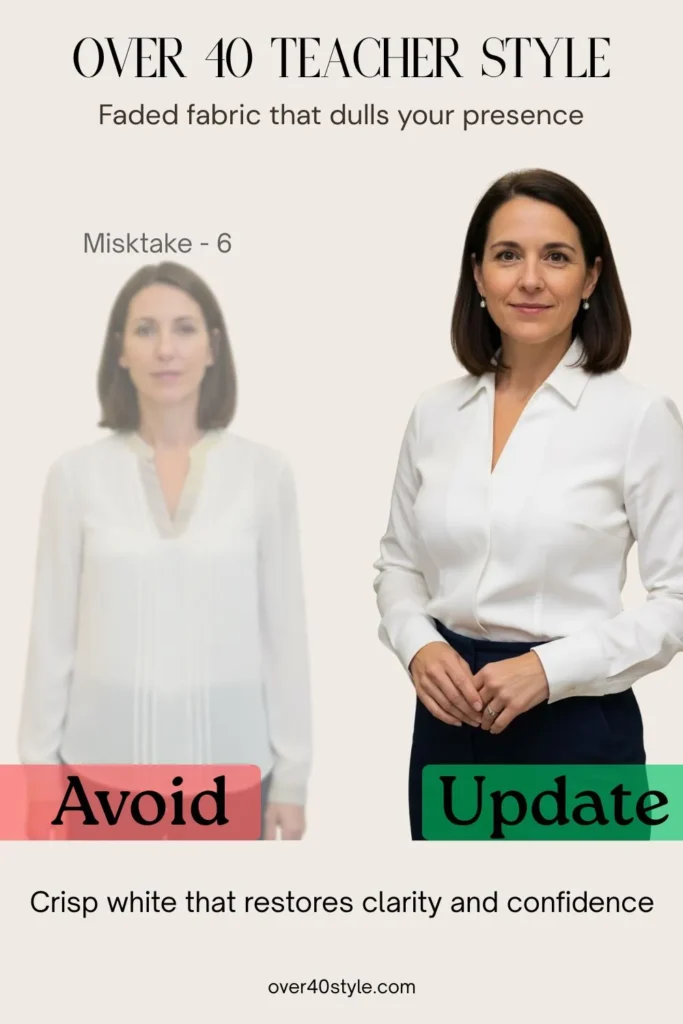
7. Holding On to “Flowy” Clothes That Are Actually Shapeless
We tell ourselves they’re comfortable. And maybe they are — easy to throw on, soft, forgiving.
But after a while, all that flow starts to blur.
What used to feel breezy now feels vague. The shape disappears. And so do you.
There’s a difference between ease and erasure. Between relaxed and forgotten. And when the clothes stop holding their structure, they stop holding your presence too.
You don’t need tight. You don’t need trendy. But you do deserve clothes that speak clearly — not just float around you.
Because showing up fully sometimes starts with wearing something that knows where you begin.
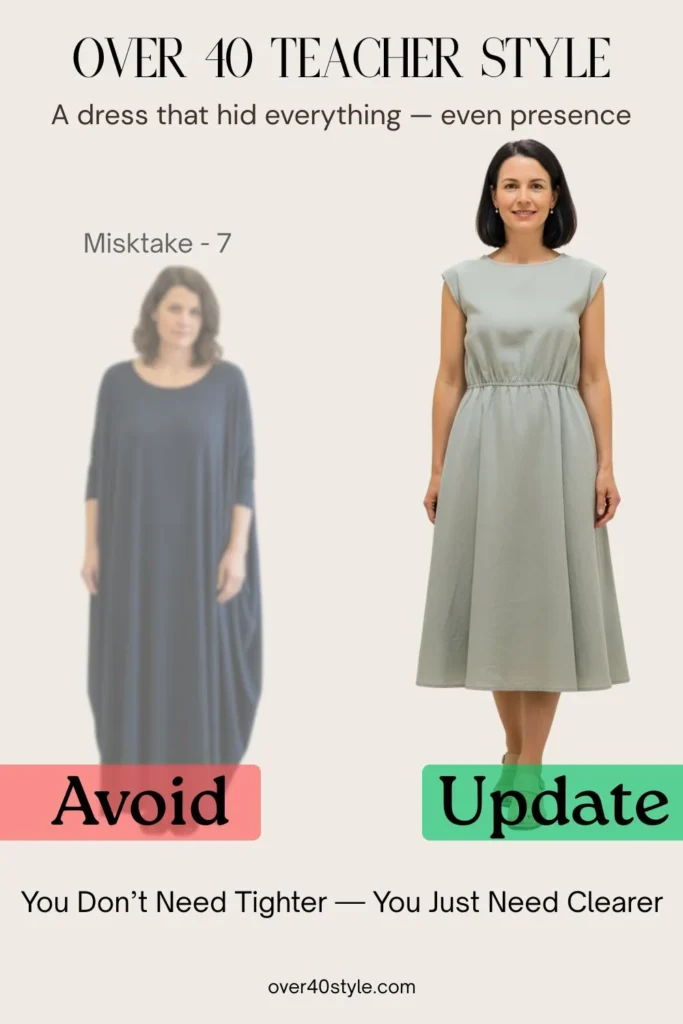
8. Skirts That Feel Fine Standing Up — But Not Sitting Down
In the mirror, it looked perfect.
But by mid-morning seated at your desk, perched on the edge of a student chair, leaning over to help with a project you’re tugging. Adjusting. Checking to make sure you’re still covered.
That’s the thing about certain skirts: they pass the standing test, but fail the sitting one. And when that happens, your attention isn’t on your students, it’s on your hemline.
It’s subtle. A shift here, a pause there. But over time, that low-grade distraction chips away at your presence.
You don’t need to give up skirts. But they should move with you, not work against you.
Because your day is filled with movement and your clothes should support that.
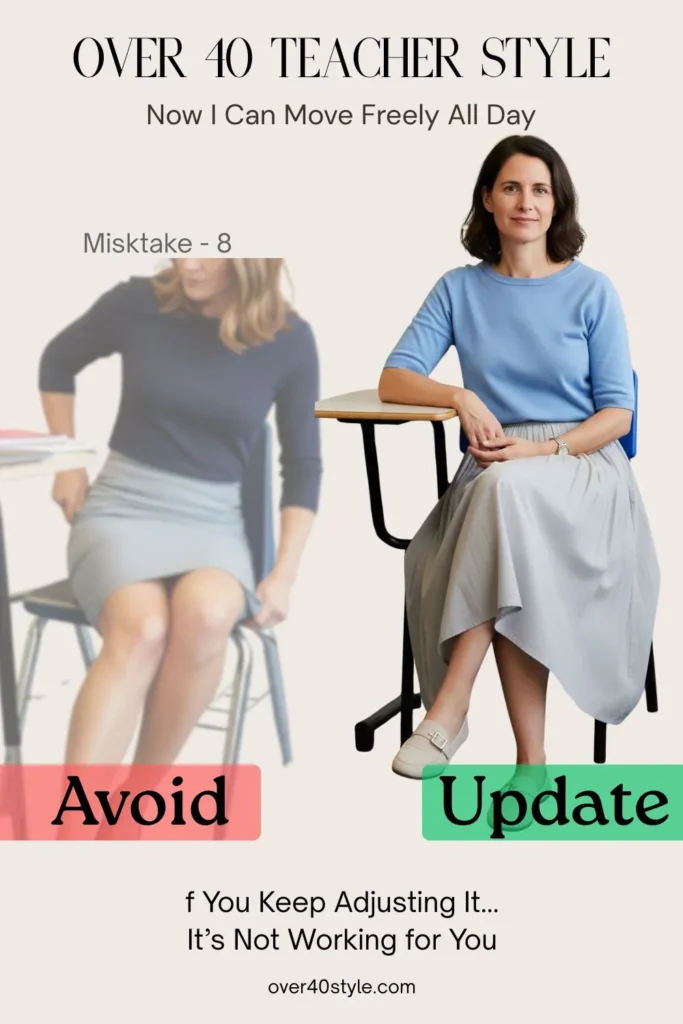
9. Wearing the Same Loose Top and Stretchy Bottom Every Day
It works. It’s comfortable. It hides the bloat and survives recess duty.
But when every outfit becomes a soft tee and leggings, something gets lost.
Energy. Identity. Voice.
Style doesn’t have to be complicated. But when everything blends into a blur, your message does too.
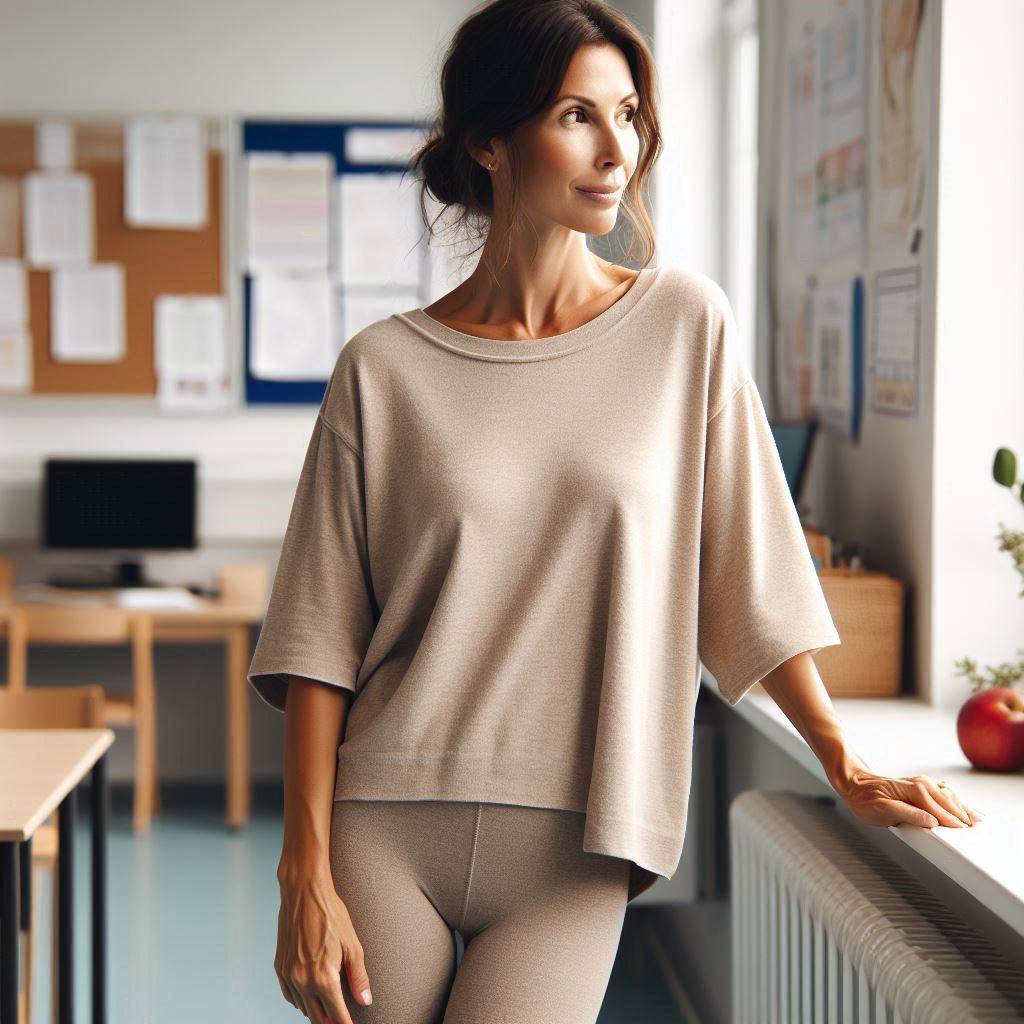
10. Wearing Strap Styles That Are More Beach Than Classroom
Some pieces just say “weekend.”
Thin straps. Deep armholes. Racerbacks. All fine — in context.
But in the classroom, especially over 40, there’s a quiet dignity that structured cuts offer. The kind that doesn’t ask for attention — but earns it.

11. Overcompensating With Bright Prints or Loud Colors
In an effort to feel fresh, we sometimes swing too far into “look at me.”
Neon florals. Loud stripes. Big bolds everywhere.
It’s not that you shouldn’t wear color. Just… ask yourself: Is this uplifting me? Or distracting from me?

12. Not Realizing How Much a Wrinkle-Prone Fabric Affects Your Look
You start your day crisp and intentional. You chose linen because it breathes — because it feels light. But by mid-morning, it’s rumpled and creased in all the wrong places.
The fabric hasn’t just wrinkled — it’s slowly unraveled the energy you started the day with.
And while you might brush it off, others see it too. The sharpness dulls. The polish fades. Presence begins to slip, quietly.
You don’t need to chase perfection. But you do deserve clothes that carry your confidence through the entire day.

13. Choosing Necklines That Shift Too Much During the Day
You start your day feeling composed. But by second period, you’ve adjusted your neckline so many times you’ve lost count.
A subtle slide here, a strap falling there — it doesn’t seem like much, until you realize your focus is being chipped away one tug at a time.
You’re here to teach, to lead, to think clearly — not to worry about coverage every time you move. Clothes that respect your body’s movement free your mind to do what it’s meant to.

14. Ignoring the Fact That Styles Change—Even If Dress Codes Don’t
You start your day in that same blouse you wore proudly five years ago. But something feels off. Not wrong — just… behind.
It still meets the rules. But it doesn’t meet you anymore.
Because while the dress code stayed the same, you didn’t. You’ve evolved. The way you speak, stand, carry yourself — it’s all grown.
And your clothes? They should grow with you.. You start your day focused, pulled together. But by the time second period ends, you’ve adjusted your neckline five times.
That subtle distraction? It adds up.
You’re not being picky — you’re being pulled away from your presence. Necklines that won’t stay put chip away at confidence in invisible ways. You’re teaching, leading, thinking — you shouldn’t also have to worry about slipping straps or shifting seams.
Clothes that stay where they belong free you to do the same.

15. Forgetting That Some Pieces “Read” Younger Than You Think
Graphic tees. Slogan sweatshirts. Light-wash ripped jeans.
They can be playful. But also — they can blur your presence in a role that carries depth, authority, and quiet power.
You don’t need to dress “older.” Just dress fully you.

16. Wearing Clothing That’s Too Thin to Hold Shape
That blouse that clings? That skirt that loses shape by lunch?
It’s not your body. It’s the fabric.
Lightweight should feel light — not flimsy.

17. Choosing Fabrics That Show Sweat Too Easily
You’re confident. Capable. Calm.
Until your shirt betrays you by third period.
Synthetic brights and slick fabrics can highlight moisture — fast. And while you shouldn’t have to worry about it, you still might.
Subtle or not, that impression matters.

18. Outfits That Require Too Much Fussing
The strap that falls. The blouse that shifts. The hem that’s too high.
If your outfit keeps interrupting your day, it’s not earning its keep.
The best pieces disappear — so you can be the one who’s seen.

19. Wearing Button-Ups That Don’t Quite Button Anymore
You can feel it: the slight pull, the quiet gap, the mental note to suck in when you sit.
And every time you feel it? You’re distracted from what really matters.
Clothes should move with you. Not hold you hostage.
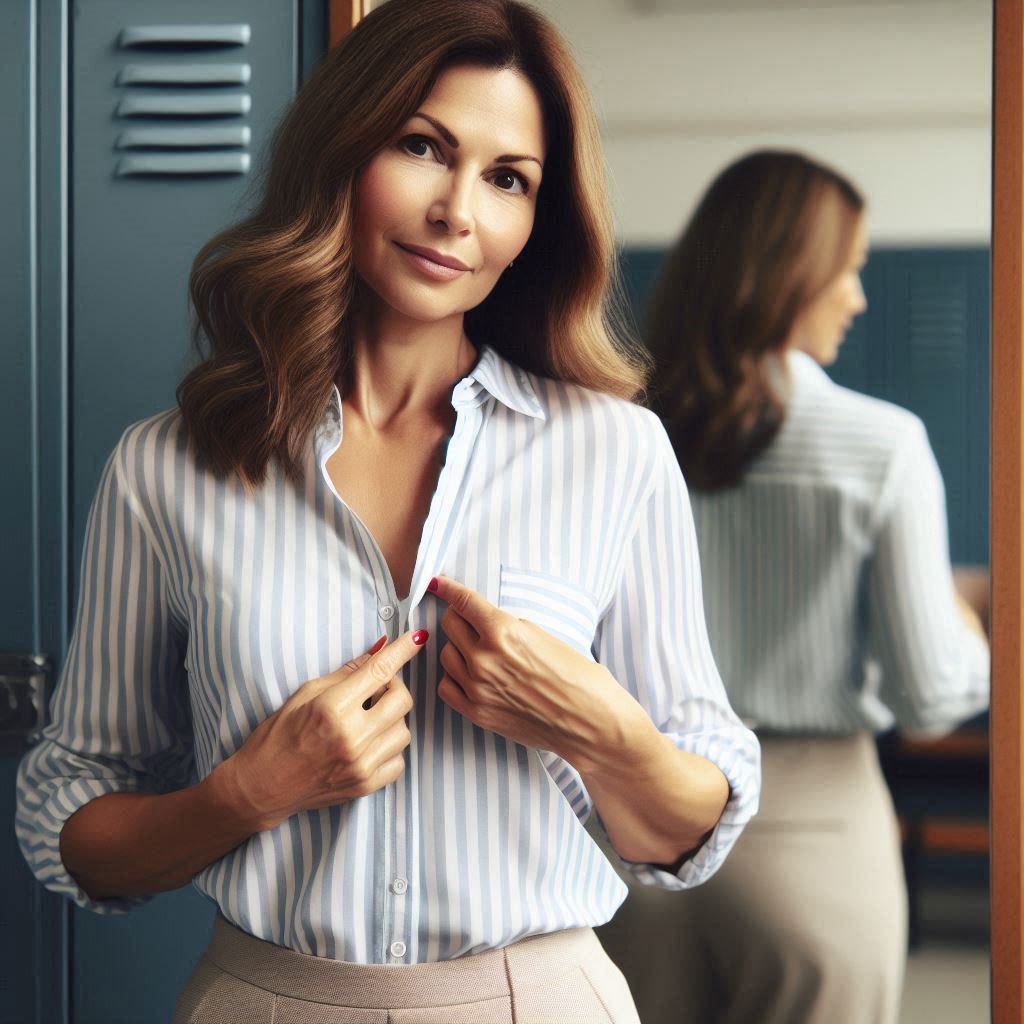
20. Defaulting to Clothes That “Used to Work”
That outfit that once made you feel strong? If it doesn’t anymore — it’s not your fault. You’ve grown.
Let it go with grace. With gratitude.
Make room for what reflects who you are now.

Final Thoughts
You’ve taught generations. Survived reform after reform. Led classrooms through chaos and change.
You’ve earned more than comfort. You’ve earned presence.
This isn’t about dressing up. It’s about showing up — fully.
Let this summer be the one where you stop blending in and start showing up as you.
Not louder. Not trendier. Just clearer.
Because the world needs what you carry — and it helps if they can see it coming.


